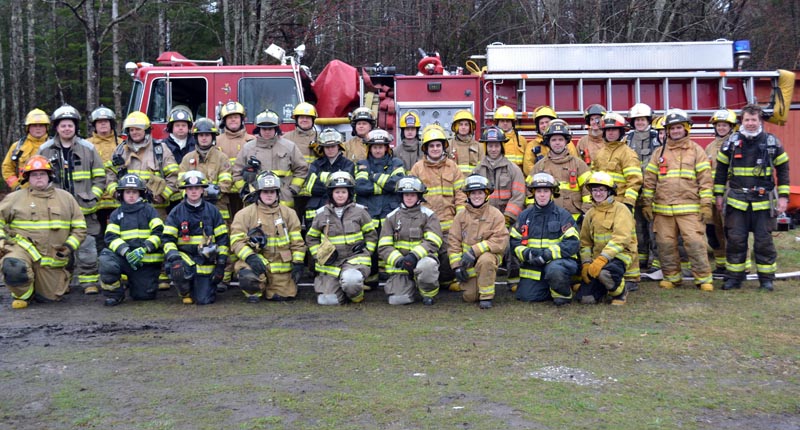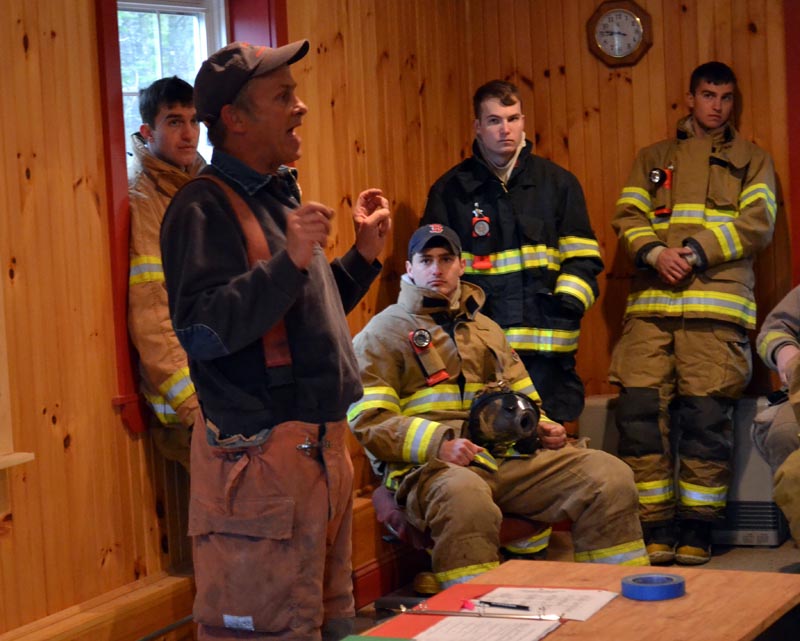
Thirty-three firefighters, the largest Lincoln County Fire Academy class in recent years, earned their basic firefighter certification after completing training Saturday, April 22. (Abigail Adams photo)
The Lincoln County Fire Academy’s biggest class of new firefighters in recent years completed training Saturday, April 22. Thirty-three firefighters took turns battling a mock structure fire at the Gordon Merry Training Facility in Wiscasset – the final step toward obtaining the certification necessary to enter burning buildings.
“It all comes down to today,” instructor David Pratt said to the class, as recruits received last-minute instructions before taking their positions around the building soon to be set ablaze. “Everything you’ve learned will come into play today.”
The basic firefighter certification requires a comprehensive two-month training course with three-hour classes twice a week, said John Long, operations coordinator for the class. For the past two months, firefighters have learned the ins and outs of fire equipment, fire safety, and fire suppression and attack.
They have learned how to battle gas fires and vehicle fires, overhaul burning structures, conduct traffic control, and respond to spills of hazardous materials, Pratt said. Many of those skills were put to the test April 22, as firefighters took turns entering into the burning, smoke-filled building.
The academy has trained about 300 firefighters since its establishment in 2007, Pratt said. A typical class includes 10-24 firefighters. The April 22 graduating class of 33 was the academy’s largest in recent years, Long said.

Woolwich firefighter Mike Thiboutot demonstrates how to safely work from a ladder during a Lincoln County Fire Academy training Saturday, April 22. (Abigail Adams photo)
Firefighters must be members of a local fire department in order to go through the training, Pratt said. With many Lincoln County fire departments struggling with retention and recruitment, the number of newly trained basic firefighters in the area is promising.
“More people are interested in volunteering,” Long said. “It’s great for us.”
Many of the volunteer firefighters who completed the training had personal reasons that drew them to the service, but contributing to the community was an overarching theme in their reasons for joining the local fire department.
Woolwich firefighter Joe Rodney joined to pay tribute to his cousin, Joey Cavallaro, a Portland firefighter who died in the line of duty in 1980.
Connor Coburn, of Westport Island, recently graduated from college and wanted to learn more about himself. “I’ve never been a courageous person, but I learned that I have a lot more courage than I thought I did,” he said.
Caitlin Shepherd, of Southport, recently returned to her hometown. A former junior firefighter, Shepherd grew up with the fire service, which her father had been a part of. She joined the Southport Fire Department “to do my part,” she said.
Jeff Whittemore recently moved to the area, and joined the Alna Fire Department to get to know the community. “Where else are you going to find better people to meet?” Whittemore said.
“This is really good community-building,” said Tom McKenzie, also of the Alna Fire Department.
Pallets and hay stakes inside the training center’s building were lit, and smoke billowed from the windows and roof. “This is true IDLH (immediately dangerous to life or health) smoke. Do not take your masks off,” Pratt said. “Air (pack) management is key to a fire attack.”
Pumper and tanker trucks from the Alna, Damariscotta, Jefferson, and Woolwich fire departments positioned themselves to provide a steady water supply. Four teams of firefighters formed to launch a coordinated attack – an initial attack team, a search-and-rescue team, a ladder team, and a backup team.

The skills learned by firefighters during the two-month basic firefighter certification course “all come into play today,” Lincoln County Fire Academy instructor David Pratt said at the final training of the academy’s largest class in recent years. (Abigail Adams photo)
The goal of the training is not to extinguish the fire, but to learn how to suppress and control it, Pratt said. Water management is crucial at a fire scene, and the first trucks to respond do not want to exhaust their water supply before help arrives, he said.
“A good interior firefighter needs to know fire,” Pratt said. “Fire and fire behavior is something that you never stop learning about. Every fire, I still learn something new.”
The initial attack team gauged the coordinates of the building and told the exterior teams where support was needed, Long said. The search-and-rescue team entered the building after them to look for anyone trapped by the fire.
Firefighters learned how to safely scale ladders to establish a ventilation point from a second-story window to clear the building of smoke. The backup team waited for its cue to attack the fire from the opposite side of the building.
“This is what it’s all about – bringing the county together and working as one team,” Long said. “This absolutely helps with mutual aid.”
The basic firefighter certification qualifies firefighters to serve on an interior attack team, but that ability is not needed to play a valuable role at a fire department, Pratt said. Entering burning buildings is not for everyone, he said, and “there are a lot of jobs at the fire department that are just as important as going inside.”
Local fire departments still need volunteers. To volunteer, contact any local fire department.






